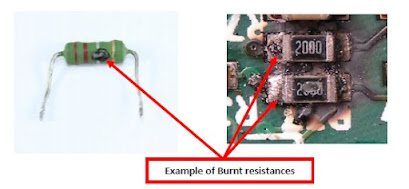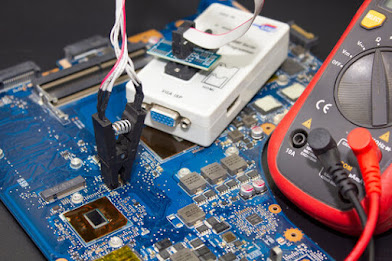Diagnostic method for laptop power supply circuit failure
The motherboard power supply circuit of the laptop computer is an indispensable part of the laptop and its problems usually lead to various failure phenomena such as failure to boot, automatic restart, and crash etc. To learn the diagnosis and elimination of the fault of the power supply circuit of the laptop motherboard: Firstly, the basic working principle should be mastered. Secondly, the common fault phenomena caused by the problem of the power supply circuit of the motherboard should be understood. Finally, the maintenance experience of the power supply circuit of the motherboard should be continuously summarized and learned. method. 1- Laptop motherboard power supply circuit basics There are two ways to supply power to the laptop motherboard. One is the dedicated rechargeable battery for laptop computers and the other is to convert 220V mains to 19,5 or 20 volts. Powered by the power adapter. The laptop's dedicated rechargeable battery typically provides a lower supply voltage than the power adapter's input supply voltage. Whether it is a dedicated rechargeable battery or a power adapter for a laptop computer, the power input to the laptop's motherboard cannot be directly used by all chips, circuits, and hardware devices. This is because the functional modules and hardware devices on the laptop motherboard. The current and voltage requirements are different and must be converted after the corresponding power supply. Therefore, various power conversion circuits on the laptop motherboard have become an indispensable part of the laptop computer. At the same time, after the problem occurs in the power supply circuit of the laptop computer, it will lead to various failure phenomena such as failure to boot, automatic restart, and crash. To learn the diagnosis and troubleshooting methods for the power supply circuit of the laptop motherboard, you must first master the working principle and common fault phenomena, so that the fault analysis can be reasonable and the troubleshooting can be quickly and accurately performed during the maintenance of the laptop.
1- Laptop motherboard power supply The power supply conversion circuit on the laptop motherboard mainly adopts two kinds of switching power supply and linear regulated power supply. The switching power supply is the most widely used power conversion circuit in laptop motherboards. Switching power supply is widely used in the system power supply circuit, CPU power supply circuit, chipset power supply circuit and memory and graphics power supply circuit on the laptop motherboard. The switching power supply uses modern electronic technology to control the "on" and "off" of the electronic switching device (such as the FET) through the power control chip to send control signals to pulse-modulate the input power, thereby realizing power conversion and automatic stabilization. The function of voltage and output adjustable voltage. The switching regulator power supply circuit applied on the laptop motherboard is usually composed of electronic components such as a power control chip, a field effect transistor, a filter capacitor, a storage inductor and a resistor. The power control chip is a power supply voltage conversion control component in the switching power supply circuit and the field effect transistor and the energy storage inductor are voltage conversion execution components in the circuit, and the capacitor in the circuit mainly plays a filtering role. The linear regulated power supply has the characteristics of low noise, fast response, simple structure, low heat generation, low cost and small size. The linear power supply is widely used in the laptop computer's standby circuit, memory power supply circuit and chipset power supply circuit. Provide one or more power supplies for it. The linear regulated power supply circuit usually consists of a small number of electronic components such as a linear regulator chip, a capacitor and a resistor. When a linear regulated power supply is used to supply a reference voltage in the memory supply circuit, it is usually designed on the motherboard. Near the memory slot when the chipset power supply circuit uses a linear regulated power supply to provide a certain power supply, it is usually designed around the motherboard chipset. 1-1- Protection isolation circuit and charging control circuit 1. Protection isolation circuit Protection the isolation circuit is an important part of the laptop computer power supply circuit. It connects the power adapter and the rechargeable battery to form the external power supply of the two-way notebook motherboard, and chooses to deliver one of the power supplies to the motherboard. Kind of power supply circuit.
The main function of the protection isolation circuit is to switch the power supply mode of the laptop. The choice is whether to use the power adapter to supply power or a rechargeable battery, and provide certain protection functions. Switching the power supply mode of the laptop means that when the laptop has a power adapter and is powered normally, the protection isolation circuit selects the power adapter to supply power to the motherboard of the laptop. When there is no power adapter power supply or the power adapter is powered abnormally, the protection isolation circuit will choose to be powered by the laptop's rechargeable battery. The protection isolation circuit of a laptop usually consists of electronic components such as a field effect transistor, a resistor, a capacitor, a triode and a charge control chip. The power supply switching function of the protection isolation circuit is mainly realized by the switching function of electronic components such as field effect transistors in the circuit. Electronic components such as field effect transistors have the property of allowing current to pass when conducting, and not allowing current to pass when they are turned off. By utilizing this characteristic of an electronic component having a switching function such as a field effect transistor, and further controlling the charging control chip in the circuit, the power supply switching function of the protection isolation circuit can be realized. In addition to the function of controlling the on and off of electronic components such as FETs, the charge control chip in the protection isolation circuit has the function of monitoring and detecting whether the voltage and current in the circuit are normal. When the external input power supply is abnormal, the protection isolation circuit cuts off the input power supply, thereby protecting the circuit of the latter stage. Different manufacturers and models of laptop, the protection isolation circuit has a certain difference in design, the above is only its basic principle, and in the troubleshooting process of the laptop, should be further analyzed according to the circuit diagram.
2. Charging control circuit The charging control circuit is also an important part of the laptop power supply circuit. Its main function is to convert the input power of the power adapter into the charging power of the rechargeable battery. The core component of the laptop charging control circuit is the charging control chip, which controls the charging process of the rechargeable battery of the laptop. The charging control circuit of a laptop usually consists of electronic components such as a charging control chip, a field effect transistor, a capacitor, an inductor, and a resistor, and belongs to a switching regulator power supply circuit. The FET in the charge control circuit receives power from the upper circuit and the charge control chip can control the turn-on and turn-off of the FET in the circuit. The inductor mainly plays the role of energy storage in the circuit. The capacitor mainly functions as a filter in the circuit. After the charging control circuit converts the input power of the power adapter, it outputs the voltage and current required for charging the rechargeable battery of the laptop. At the same time, the charging control chip can also detect and monitor the charging process to prevent damage to the rechargeable battery. Problems with the protection isolation circuit and charging control circuit of the laptop will cause the laptop to fail to boot normally, and the rechargeable battery cannot be charged normally. 3. The circuit analysis Charging control chip is the core of the laptop protection isolation circuit and the battery charging control circuit, and has the functions of detecting and controlling the working process of the whole circuit. The following takes the ISL6251 charging control chip as an example to elaborate the basic working principle of the laptop protection isolation circuit and the charging control circuit. The ISL6251 charge control chip is a highly integrated battery charge controller that not only controls the battery charging process of the laptop, but also controls the power supply between the power adapter and the rechargeable battery by controlling the externally connected FET. The ISL6251 charge control chip has accurate charging current limiting function, and its charging voltage accuracy can reach ±0.5% (-10°C~100°C), thus ensuring the safety of the battery charging process and prolonging the service life of the rechargeable battery, as shown in Figure 1. The pin diagram and internal functional block diagram of the ISL6251 charge control chip are shown.






Thank you for sharing this informative article about diagnostic methods for laptop power issues. Power problems can be quite frustrating, and your article provides valuable insights into troubleshooting and diagnosing these issues effectively. The step-by-step guide and diagnostic techniques outlined will undoubtedly assist technicians and users in identifying and resolving power-related problems with laptops. HP Service Center Chennai This resource is a great reference for anyone facing power issues and seeking practical solutions. Keep up the good work!
ReplyDelete